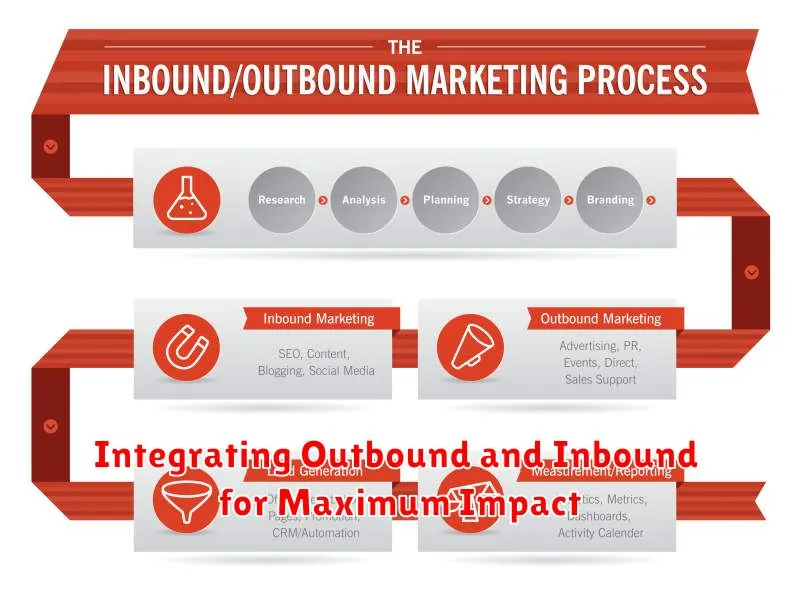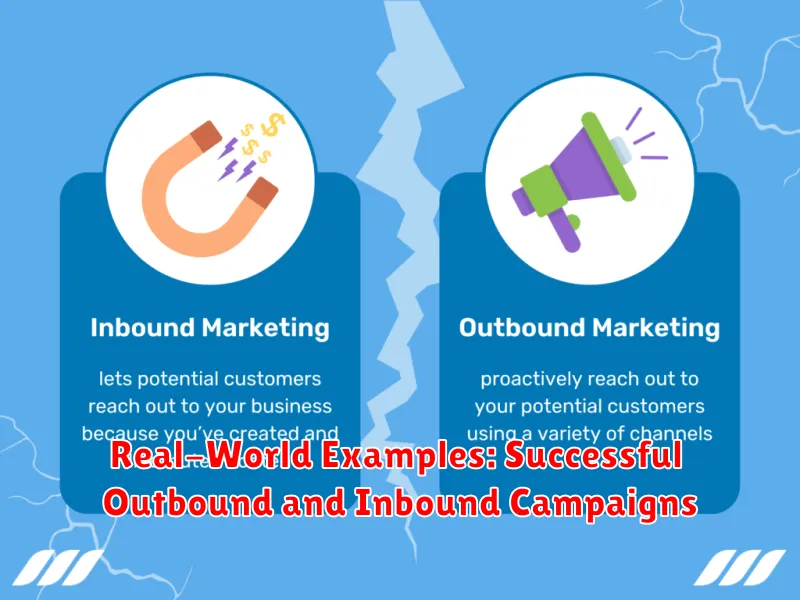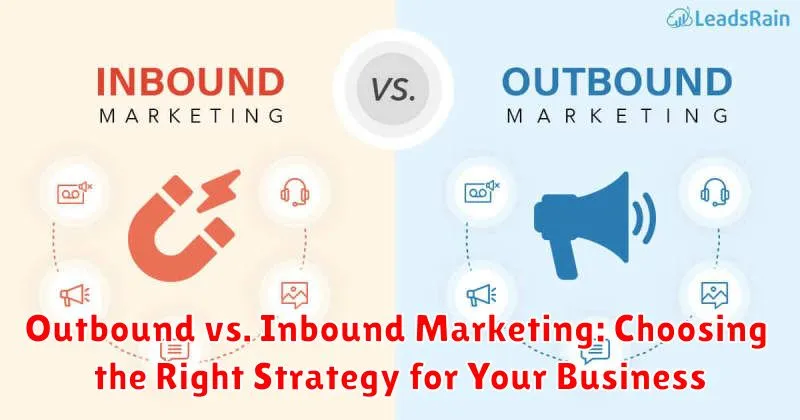In today’s dynamic business landscape, choosing the right marketing strategy is crucial for success. This article delves into the core differences between two dominant approaches: outbound marketing and inbound marketing. Understanding the nuances of each method is paramount for businesses aiming to effectively connect with their target audience and achieve their marketing objectives. Whether your business is established or just starting out, selecting between outbound and inbound strategies, or finding the right balance of both, can significantly impact your return on investment and overall growth.
Outbound marketing traditionally involves pushing promotional messages out to a broad audience, often regardless of their interest. Inbound marketing, conversely, focuses on attracting potential customers in by creating valuable content and experiences tailored to their needs. This article will explore the advantages and disadvantages of both outbound and inbound marketing, providing you with the necessary insights to determine the most effective strategy, or combination of strategies, for your specific business needs and target market. By understanding the core principles of each methodology, you can make informed decisions to maximize your marketing efforts and drive business growth.
Understanding Outbound Marketing
Outbound marketing is a proactive approach where businesses initiate the conversation and send their message out to a broad audience. It’s about interrupting consumers, rather than waiting for them to find you. Think of it as pushing your message outward.
Traditional outbound marketing tactics include methods like:
- Print advertising: Newspaper ads, magazine spreads, flyers.
- Television and radio commercials: Paid advertising slots.
- Cold calling: Unsolicited phone calls to potential customers.
- Direct mail marketing: Sending physical mailers like brochures or catalogs.
- Trade shows: Setting up booths and showcasing products or services.
While outbound marketing can still have its place, its effectiveness has been declining in recent years. Consumers are increasingly resistant to interruptive advertising and are more likely to engage with content they seek out themselves.
Exploring the Power of Inbound Marketing
Inbound marketing focuses on attracting potential customers to your business by creating valuable content and experiences tailored to their needs. Instead of interrupting their day with unwanted messages, inbound strives to be helpful and informative, building trust and establishing your brand as a resource.
Content creation is central to inbound strategy. This includes blog posts, articles, infographics, videos, and other forms of media that provide value to your target audience. By addressing their pain points and answering their questions, you position your business as an authority in your field.
Search engine optimization (SEO) ensures your content is easily discoverable by potential customers searching online for solutions. By optimizing your website and content for relevant keywords, you increase your visibility in search engine results.
Social media marketing plays a key role in inbound, allowing you to connect with your target audience, share valuable content, and build relationships. By actively engaging with your followers, you can foster a loyal community around your brand.
The core principle of inbound is to attract, engage, and delight customers. By providing value upfront, you earn their trust and increase the likelihood of them choosing your business over competitors.
Key Differences: Outbound vs. Inbound
Outbound and inbound marketing represent fundamentally different approaches to reaching potential customers. Outbound marketing pushes a message out to a broad audience, often regardless of their interest. Conversely, inbound marketing focuses on attracting interested individuals in by creating valuable content and experiences tailored to their needs.
A key difference lies in the initiation of contact. Outbound marketing proactively initiates the conversation, such as through cold calls or TV ads. Inbound marketing waits for the customer to initiate contact after discovering the business through online searches, social media, or engaging content.
Another significant difference is the level of targeting. Outbound marketing typically casts a wide net, resulting in reaching many uninterested individuals. Inbound marketing allows for a more targeted approach, attracting individuals who have already demonstrated an interest in the product or service.
Finally, control distinguishes these approaches. With outbound, businesses control the message and its delivery. Inbound gives more control to the consumer, who chooses which content to consume and whether to engage.
Matching Your Strategy to Your Audience
Selecting the right marketing approach hinges on understanding your target audience. Different demographics respond differently to various marketing techniques. Consider these factors when aligning your strategy:
Audience Demographics
Age plays a significant role. Younger audiences are often more receptive to digital inbound strategies like social media and content marketing. Older demographics may respond better to more traditional outbound methods such as direct mail or print advertising.
Where Your Audience Spends Their Time
Consider where your target audience spends their time online and offline. Are they active on specific social media platforms? Do they read industry publications? This information informs whether inbound or outbound, or a combination of both, is more effective.
Buying Behavior
Understanding your audience’s purchasing habits is crucial. Are they impulsive buyers or do they conduct extensive research before making a purchase? Inbound excels at nurturing leads through the sales funnel, while outbound can be effective for prompting immediate action.
Budget Considerations: Outbound vs. Inbound
Budget allocation is a crucial factor when deciding between outbound and inbound strategies. Outbound marketing traditionally requires a larger upfront investment. Expenses include purchasing ad space, printing materials, and securing airtime. These costs can be substantial, especially for broader reach campaigns.
Inbound marketing, while often perceived as less expensive, still requires investment. Costs are associated with content creation, SEO optimization, social media management, and marketing automation software. While initial costs may be lower than outbound, ongoing investment is crucial for sustained success.
Ultimately, the “best” budget depends on business size, target audience, and overall marketing goals. Small businesses with limited resources might find inbound methodologies more accessible initially. Larger enterprises with established brand presence may utilize a combination of both, leveraging existing resources for outbound efforts while building a robust inbound strategy for long-term growth.
Measuring Success: ROI and Key Metrics
Accurately measuring the success of your marketing efforts is crucial for demonstrating value and optimizing future campaigns. A key metric is Return on Investment (ROI), which calculates the profit generated for every dollar spent on marketing. A higher ROI signifies a more effective strategy.
For outbound marketing, ROI can be tracked by analyzing metrics like cost per lead, conversion rates from cold calls or email blasts, and the overall value of deals closed through these channels. Direct mail campaigns can be assessed by tracking response rates and subsequent conversions.
Inbound marketing ROI measurements often focus on website traffic, lead generation from content downloads or form submissions, and the conversion rate of leads into paying customers. Metrics like website engagement (time on page, bounce rate) and social media engagement also provide valuable insights into campaign effectiveness.
Integrating Outbound and Inbound for Maximum Impact

While outbound and inbound marketing are often presented as separate entities, a truly effective strategy leverages the strengths of both. Integrating these approaches creates a synergistic effect, maximizing reach and impact.
Outbound tactics can be used to generate initial awareness and drive traffic to inbound resources. For example, a targeted advertising campaign can direct potential customers to a landing page with valuable content, like a whitepaper or webinar registration. This captures lead information and nurtures them through the inbound funnel.
Conversely, inbound activities can provide valuable data to refine outbound efforts. Analyzing website analytics and content engagement can reveal valuable insights about target audience preferences and pain points. This data can then be used to create more effective and targeted outbound campaigns, such as personalized email marketing or direct mail.
By strategically aligning outbound and inbound activities, businesses can create a more comprehensive and impactful marketing strategy. This integrated approach fosters stronger brand awareness, generates higher quality leads, and ultimately drives increased conversions and revenue.
Long-Term Growth: Building a Sustainable Marketing Plan
A sustainable marketing plan requires a long-term vision, adapting to evolving market dynamics while maintaining core brand values. It’s not about chasing short-term gains, but building a resilient strategy for consistent growth.
Key elements of a sustainable plan include:
- Customer-centricity: Prioritizing customer needs and building lasting relationships.
- Data-driven decisions: Analyzing marketing performance and adapting strategies based on insights.
- Diversification: Exploring various marketing channels and not relying solely on one method.
- Content strategy: Creating valuable, evergreen content that attracts and retains customers over time.
- Budget allocation: Planning for consistent investment in marketing activities, avoiding drastic cuts or spikes.
By focusing on these core elements, businesses can build a marketing plan that delivers consistent results and positions them for long-term success in a competitive market.
Real-World Examples: Successful Outbound and Inbound Campaigns

Outbound Example: A software company targeted specific businesses with personalized cold emails showcasing the benefits of their product. This campaign resulted in a significant number of demos scheduled and ultimately contributed to increased sales.
Inbound Example: A fitness center created a series of blog posts and videos about healthy living and exercise tips. This content, optimized for relevant keywords, attracted organic traffic to their website, generating leads through a free trial signup form.
Integrated Example: An e-commerce store advertised a flash sale through paid social media ads (outbound). Simultaneously, they promoted related blog content focusing on styling tips and product benefits to engage their existing email subscribers (inbound), creating a synergistic approach that boosted sales and brand awareness.

